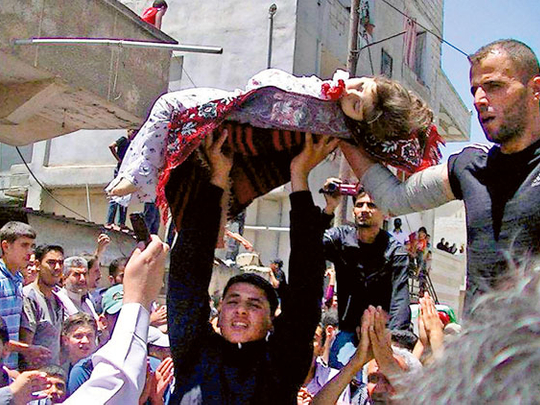
Last week’s international conference in Geneva, seeking an agreement on a path to resolving the crisis in Syria, produced vague proposals for a transition government, which is unlikely to go anywhere but Kofi Annan’s personal archive. Despite this failure, new Human Rights Watch reports of systematic torture by the Bashar Al Assad regime and the continuing call for intervention from many activists, including the Free Syrian Army, it is unlikely that there will be any armed foreign intervention in Syria as there was in Libya.
The tactical situation in Libya made intervention relatively easy: Essentially all that was needed to prevent a massacre of civilians in Benghazi was to interdict Muammar Gaddafi’s forces along a single road running eastward along the Mediterranean shore to that city. This was done and lives were saved. Such a situation does not exist in Syria, where the planes or missiles would have to attack formations surrounding many cities and towns as well as locate the bases of the less visible government-sponsored militias.
Whereas Libya’s regime was unpopular with just about everybody in the Arab world and the West, Syria is Russia’s last remaining ally in the region and also the most important ally of Iran. Various international agreements made since 1945 might seem to give legitimacy to international intervention, specifically to attempts to give effective aid to victims attacked by the Syrian government and its militias.
Chapter VII of the UN charter authorises “such action by air, sea or land forces as may be necessary to maintain or restore international peace and security”. The French Foreign Minister, Laurent Fabius, invoked this provision last month when he said France would push the UN Security Council to enforce Annan’s peace plan and ceasefire. However, a probable ongoing Russian veto in the Security Council makes such a resolution unlikely to be adopted.
The would-be interveners will be left with only a “Kosovo” option: Nato actions, independent of the UN. Yet, even in the Kosovo crisis, the Serbian defeat depended on Russia’s eventual withdrawal of support for Milosevic as much as it did Nato’s bombing.
The Genocide Convention of 1948, signed by almost all countries, has not prevented any genocide from running its course, whether in Cambodia, Guatemala, Rwanda or Sudan. In any case, policy advisers will probably say that this convention does not apply to Syria because the targets of the regime do not fit the convention’s criteria — they are not a “national, ethnical, racial or religious group;” they are “merely” political opponents, a category not included in the convention.
More relevant is the “Responsibility to Protect” resolution, passed unanimously by the UN in 2005, accepting the responsibility of all governments to protect citizens of any other country being attacked by their own governments. The Responsibility to Protect resolution, however, leaves many avenues for states to escape having to intervene effectively, an escape that has proven to be the preferred option in cases like Sudan.
Al Assad has successfully kept out the international press and has prompted the failure of the UN monitor mission by restrictions and deliberately inadequate protection. The operators of amateur social media have not been able to compensate effectively for such blockage. World leaders could be hesitant to create an intervention policy based on the killing of children, for example, when it is not fully clear who did the killing.
They have perhaps learned a lesson from the babies allegedly killed in Kuwait in 1990 by Saddam Hussain’s soldiers, according to the congressional testimony of Kuwaiti diplomats. When investigators attempted to confirm these stories after Iraq was expelled from Kuwait in 1991, they turned out to be fabrications.
Despite its rhetoric condemning the Syrian regime, there is also reason to doubt that Washington really wants Al Assad to fall. Al Assad’s regime is a “known devil” and one with demonstrated weaknesses — witness its expulsion from Lebanon and its defeats by Israel. At the same time, it has a professional and mostly loyal army and an identifiable and mostly loyal power base in one-fifth of the population — the Alawite and Christian minorities.
The Free Syrian Army and other adversaries of Al Assad are far less professional and unified, with a possibly far more volatile power base — the country’s Sunni Muslim majority.
Nor does the American and UN response to the Sudanese government’s atrocities give Syrians cause to hope for a rescue. Despite the fact that in Darfur alone the Sudanese government, under Omar Al Bashir, has caused the death of nearly a 100 times more civilians and created 80 times more refugees than Al Assad has done in Syria, the US has never seen fit to arm Darfur rebels.
Elie Wiesel has called for Al Assad to be charged with crimes against humanity. Although such a charge will serve as a gesture of moral concern and solidarity with the Syrian people, it will probably not deter the Syrian president from continuing his attacks.
It is more than likely, therefore, that an assessment of American and international policy towards intervention in the Libyan and Sudanese cases will do little to shake the Syrian government’s confidence, that it can continue down a path of the most ruthless repression.
The Syrian people themselves — with an enduring courage that has prompted a growing but still small number of high Syrian officers to abandon the regime — are the only ones who can convince Al Assad that it is time to choose a less murderous path.
John Hubbel Weiss is an associate professor of History at Cornell University.









